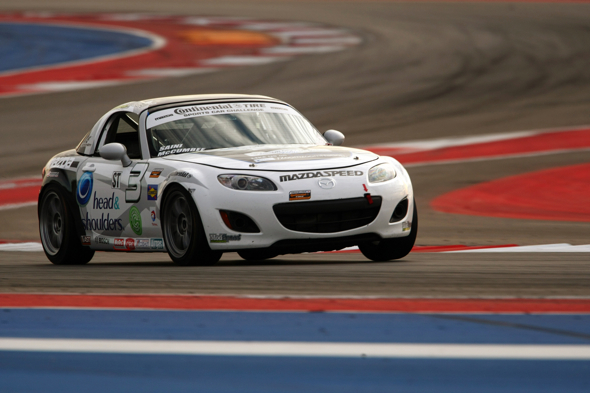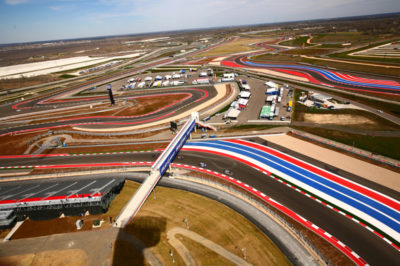In 2013, the drivers in the Grand-Am Continental Tire Sports Car Challenge raced on some tracks that many had not seen before, at least not while driving in the Continental Tire series. Circuit of the Americas, Road Atlanta and Kansas Speedway were all new additions to the schedule.
That means new tracks for the drivers to learn. Mastering new circuits quickly is a skill that every successful driver needs to have in his or her arsenal. The CJ Wilson Racing drivers, pilots of the Nos. 3 and 5 ModSpace/CJ Wilson Children’s Charities Mazda MX-5s in the Street Tuner category, have some tips for getting new tracks down.
“When you go to a track, you work your way backward out of a corner,” explains Tyler McQuarrie, who pairs with Chad McCumbie in the No. 3. “You find your apex. Once you find your apex, you can kind of find your full-throttle point, where you think it’s going to be, then you start working on your rolling-in speed after your turn-in, then you start working on braking points. By piecing it together kind of backward, it prevents you from overcharging a corner. From that point, you fine-tune it to get everything out of the corner.”

That works for multiple corners that are linked together, not separated by a straight – Esses, chicanes and the like. Armed with the knowledge that the last corner before the straight is almost always the most important because it’s critical to exit that corner with the most speed that you will then carry down the straight, you can work the other turn or turns out. “Getting the correct apex in that corner is going to be dictated by your run out of the previous corner. You’re still working backward and prioritizing those corners,” says McQuarrie.
McQuarrie cites that technique as a way to not hit a turn too hot as a method of learning the limits. His teammates, though, are quick to give him a little grief and point out he doesn’t always follow his own advice. For Stevan McAleer, the freshman driver paired with Marc Miller, finding the limits by exceeding them sometimes works.
“Circuit of the Americas is one of those tracks where you’d be really pushed to hit something,” he says. “There was so much runoff area, because it’s designed for Formula 1. You know you can overcharge a corner and, if you don’t make it, you drive over some gravel or over some racetrack. Whereas you go to a place like Watkins Glen, the first time that you put two wheels off, the car’s on a flatbed and you’re losing sessions. Watkins Glen is one of those tracks where my approach is a little bit different. I take a little time to get up to speed and pick the corners I can overcharge.”
This quartet has a luxury that most Club Racers don’t – teammates from whom to learn. Even better, especially for a driver like McCumbie, who comes form an oval racing background, is their data.
“Having data acquisition to look at and being able to compare yourself potentially takes days off of having to learn a racetrack and learning what the capabilities of the car are at the racetrack,” says McCumbie. “Going to a place like COTA or Kansas, I’ve really enjoyed it because everybody’s on a fresh page.”
“The great thing about having data acquisition and other very good drivers,” adds Miller, “is you can always learn something from how someone approaches a corner, especially a segmented-type corner. Circuit of the Americas is a perfect example. You can charge two out of the three [corners] and be slower than if you maintained a consistent run through it all together.”
While data acquisition systems are getting more affordable each year, they still aren’t tools available to every racer; even more rare is the opportunity to compare data with another driver. The rest of that advice, though, is available to all and comes at the best price.


 ACCESSIBILITY
ACCESSIBILITY